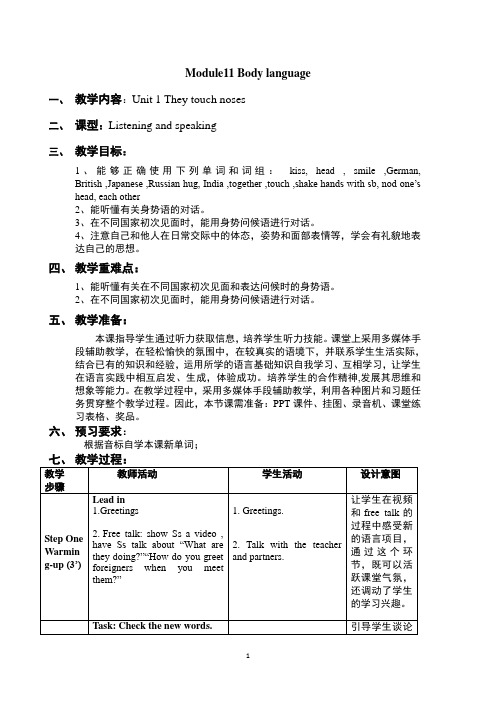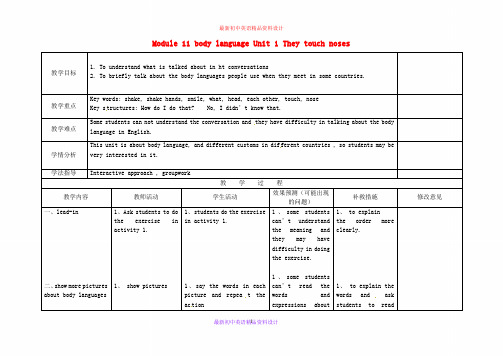初中英语Module11 Body language单元教学设计以及思维导图
外研版英语(新标准)七年级下册Module 11 Body language教案

Module 11 Body languageUnit 1 They touch noses!一、教学目标1. 语言知识目标:1) 能正确使用下列单词和词组:kiss, shake hands, smile, German, British,Japanese, Russian, hug, India, together, nod one’s head, each other...2) 能听懂有关手势语的对话。
2. 情感态度价值观目标:1) 学习一些见面礼仪。
2) 了解西方国家的风土人情和习俗。
二、教学重难点1. 教学重点:能听懂有关在不同国家初次见面和表达问候时的手势语。
2. 教学难点:中西方人们见面礼仪的差别;培养学生跨文化交际意识。
三、教学过程Step 1 Leading-in1.Review the key words about human body.2.Learn the new words学习新词汇,播放词汇音频。
3.Shows some body action and ask students to guess the meaning.老师自己或请两名同学上台表演,其他同学猜测肢体语言所传达的含义。
Step 2 Match1. Ask the students to look at the pictures and say what body language they cansee.2. Match the pictures with the words and expression from the box.Step 3 Listening1. Play the tape, ask the students to listen and match the pictures with thenationality in Activity 2.2. Work in pairs and check the right answers each other.Step 4 Reading1.Guide the students to listen to the conversation in Activity 3 and answer thequestion:What so the people in China/US/India/New Zealand do when they meet?1)In China a. shake hands, kiss or hug each other2)In the US b. shake hands, smile or nod heads3)In India c. touch nose4)In New Zealand d. put their hands together and nod theirheads2. ScanningScan the language and answer the questions:1)Who will come to Linging’s school?2)What will Maori people do when they meet?3. Careful readingAsk the students to read the dialogue carefully and complete the table with the correct form of the words from the box.Step 5 Post-reading1. Let the students act out the dialogue.2. Show some pictures and things to organize the students to talk about them.3. Have the students act out their new dialogues.Step 6 listen and repeatListen to the recording and pay attention to the pronunciation.Step 7 Group workMake a conversation to talk about what you do and say when you meet.--- What do you do and say when you meet your teacher in the morning?--- I smile and say good morning.Step 8 Language points1. … in Russia, people usually kiss three times, left, right, left.kiss v.吻,亲吻eg. The mother kissed the sleeping baby on his head.妈妈亲了一下这个睡着的婴儿的额头。
初中英语Module11 Body language单元教学设计以及思维导图

Module11 Body language适用年级初一年级所需时间课内共用5课时,课外用1课时主题单元学习概述(说明:简述主题单元在课程中的地位和作用、单元的组成情况,单元的学习重点和难点、解释专题的划分和专题之间的关系,单元的主要的学习方式和预期的学习成果,字数300-500)本单元是七年级第11模块“Module11 Body language”。
本模块的核心话题是谈论不同国家的风俗习惯,了解各国风俗文化差异,因此了解初次见面的礼仪、餐桌礼仪是教学重点。
通过对本单元的学习,学生能掌握本单元出现的的词组及句型。
以谈论自己或他人在不同场合应该做什么为主线,兼顾交际功能的学习,以一种循序渐进的生活化的学习程序,引导学生学会用英语介绍自己或他人的同国家的风俗习惯。
本单元的教学内容与学生的实际生活密切相关,易于引发学生运用简单的英语进行交际和交流。
在学习活动中,学生能通过合作交流比较不同的文化差异。
主题单元规划思维导图(说明:将主题单元规划的思维导图导出为jpeg文件后,粘贴在这里;如果提交到平台,则需要使用图片导入的功能,具体操作见《2013学员教师远程研修手册》。
)主题单元学习目标(说明:依据新课程标准要求描述学生在本主题单元学习中所要达到的主要目标)知识与技能:1、语言知识1)词汇:kiss bow table manners chopsticks fork spoon napkin greet rude wipe point stick2)短语: be supposed to do3)句型:What are you supposed to do when you meet someone? You are supposed to kissWhen were you supposed to arrived ? I was supposed to arrived at 7 ,but I arrived at 8.It’s polite to make noise while eating noodles.2、语言技能1)能描述自己或他人在不同的场合应该做什么2)讨论不同国家的风俗习惯,如初次见面的礼仪、餐桌礼仪3能掌握本单元出现的表示风俗礼仪的词组及句型,并能结合实际生活进行灵活运用这些词组及句型描述异国风俗,,提高写作水平。
外研版英语(新标准)七年级下册Module 11 Body language教学设计

Module11 Body language一、教学内容:Unit 1 They touch noses二、课型:Listening and speaking三、教学目标:1、能够正确使用下列单词和词组:kiss, head , smile ,German,British ,Japanese ,Russian hug, India ,together ,touch ,shake hands with sb, nod one’s head, each other2、能听懂有关身势语的对话。
3、在不同国家初次见面时,能用身势问候语进行对话。
4、注意自己和他人在日常交际中的体态,姿势和面部表情等,学会有礼貌地表达自己的思想。
四、教学重难点:1、能听懂有关在不同国家初次见面和表达问候时的身势语。
2、在不同国家初次见面时,能用身势问候语进行对话。
五、教学准备:本课指导学生通过听力获取信息,培养学生听力技能。
课堂上采用多媒体手段辅助教学,在轻松愉快的氛围中,在较真实的语境下,并联系学生生活实际,结合已有的知识和经验,运用所学的语言基础知识自我学习、互相学习,让学生在语言实践中相互启发、生成,体验成功。
培养学生的合作精神,发展其思维和想象等能力。
在教学过程中,采用多媒体手段辅助教学,利用各种图片和习题任务贯穿整个教学过程。
因此,本节课需准备:PPT课件、挂图、录音机、课堂练习表格、奖品。
六、预习要求:根据音标自学本课新单词;达标训练题一、选择填空。
1. He stood up and shaked hands ______visitors.A. withB. inC. onD. of2. My sister has a pen pal. She is from______.A. CanadaB. JapaneseC. EnglishD. Australian3. Let’s _____for a walk.A. to goB. goingC. goD. gone4. Welcome back ____ Russia.A. toB. in C of D. for5. We _____go swimming on Sundays in summerA.some timesB.sometimeC.sometimesD.some time 二.根据句意和汉语提示写出所缺的单词1. They usually _______(触摸) noses.2. They are going to the park ________(一起)3. The teacher asked us to help _______(每一个) us4. Lily ______(点头) her head and said “No”5. Lisa ______(微笑) because she was pleased to see you .Module11 Body language一、教学内容:Unit 2 Here are some ways to welcome them二、课型:Reading and writing三、教学目标:1、能够正确使用下列单词和词组:finger, foot, knee, leg, mouth ,body, foreign ,personal, arm, hold , move , Britain, polite, somewhere, wave, bring, not at all, in fact, wave to say goodbye, on time.2、能读懂简单的介绍不同国家身势语的短文。
外研版七年级下册英语《Module 11 Body language Unit 1》教学设计

外研版七年级下册英语《Module 11 Body language Unit 1》教学设计一. 教材分析外研版七年级下册英语《Module 11 Body language Unit 1》主要介绍了身体语言的基本概念以及各种手势、面部表情等在日常交流中的作用。
本单元话题贴近学生生活,有利于激发学生的学习兴趣,提高他们的语言运用能力。
本课时的主要内容包括:词汇的学习,如hand gesture, facial expression等;句型的学习,如“What does this gesture mean?” “He is smiling at you.”等;以及听力练习和口语交流。
二. 学情分析七年级的学生已经掌握了基本的英语语法和词汇,具备一定的听说读写能力。
但对身体语言的认识和理解还不够深入,需要在日常生活中多加观察和实践。
学生在学习过程中可能会遇到一些生词和短语,需要通过教师的引导和帮助来掌握。
三. 教学目标1.知识目标:学生能够掌握与身体语言相关的词汇和句型,理解身体语言在日常交流中的重要性。
2.能力目标:学生能够运用所学知识进行简单的听力练习和口语交流,提高自己的语言运用能力。
3.情感目标:学生通过学习,增强对身体语言的观察和理解,促进人际交往的和谐。
四. 教学重难点1.重点:学生能够掌握与身体语言相关的词汇和句型。
2.难点:学生能够正确运用所学知识进行听力练习和口语交流。
五. 教学方法1.情境教学法:通过设定各种生活情境,让学生在实际语境中学习和运用身体语言。
2.交际法:鼓励学生进行小组讨论和角色扮演,提高他们的口语交流能力。
3.任务型教学法:通过完成各种任务,让学生在实践中学习和掌握身体语言。
六. 教学准备1.教师准备:准备好相关的教学材料,如PPT、听力材料、词汇卡片等。
2.学生准备:学生提前预习课文,了解基本概念。
七. 教学过程1.导入(5分钟)教师通过展示一些图片,如不同的手势和面部表情,引导学生观察并猜测其含义,激发学生的兴趣。
最新外研版七年级英语下册 Module 11 body language Unit 1 They touch noses教案2

Module 11 body language Unit 1 They touch noses教学目标1. To understand what is talked about in ht conversations2. To briefly talk about the body languages people use when they meet in some countries.教学重点Key words: shake, shake hands, smile, what, head, each other, touch, nose Key s tructures: How do I do that? No, I didn’t know that.教学难点Some students can not understand the conversation and they have difficulty in talking about the body language in English.学情分析This unit is about body language, and different customs in dif ferent countries , so students may be very interested in it.学法指导Interactive approach , groupwork教学过程教学内容教师活动学生活动效果预测(可能出现的问题)补救措施修改意见一、lead-in二、show more pictures about body languages 1、Ask students to dothe exercise inactivity 1.1、 show pictures1、students do the exercisein activity 1.1、say the words in eachpicture and repea t theac tion1、some studentscan’t understandthe meaning andthey may havedifficulty in doingthe exercise.1、some studentscan’t read thewords andexpressions about1、 to explainthe order moreclearly.1、 to explain thewords and askstudents to read最新初中英语精品资料设计1三、listen to thetape and match the pictures with the nationality in activity 2.四、Act and guess 1、go through thenationalities in thebo x with the class.Ask where they arefrom.2、Ask students todescrib e the picturesin pairs with theirown words and guesstheir nationalities.3、 Play the recordingand tell students todecide which pictureis described.4、 check the answers.1. ask one students tocome to the front andact out the words onthe PPT, then the1、go through thenationalities in the boxand answer the teacher’squestions.2、describe the pictures inpairs with their own wordsand guess theirnationalities.3、listen to the tape anddecide which picture isdescribed in the tape.4、 elicit answers from theclass and ask students tosay why.1. one students to come tobody language.1、some studentsmay not know thewhere are thepeople in thepicture from.2. students can’tdescribe thepictures with theirown words.3、students areunable tounderstand theconversation in thetape.4. some studentsmay give the wronganswers.1. some studentsmay not understandtheir classmates.afte r the teacher.1、ask otherstudents to answerthe question untilsomebody give thecorrect answers.2、the teacher givethem an example.3、play the tapeagain.4. ask otherstudents to answerthe question andthe teacher cangive the answerstoo.1. a sk theirclassmates for the最新初中英语精品资料设计2五、Introduce more about the body language in different countries 六、Homework other students guess.Show students PPTthe front and act out thewords on the PPT, then theother students guessanswers.板书设计Module 11 Body languageUnit 1 They touch noses Bow : 3 Homework: Kiss: 1Shake hands: 2Smile: 1 2 3参考书目及推荐资料七年级下英语教材教学反思最新初中英语精品资料设计3。
外研七下Module11《Body language》word教案

Module 11 Body language【教学内容分析】本模块以肢体语言为话题。
比较详细的介绍了各国的肢体语言,利用对话等相关内容展示了各国应该遵守的肢体语言规则。
内容充实,且功能性强,学生在语言学习和语言训练的同时可以了解更多的外国文化。
本模块的语法内容是祈使句。
掌握祈使句的定义及特点。
会运用祈使句表达自己的情感、命令和要求。
教师在教学的过程中要运用归纳法来帮助学生形成一个整体的概念。
【学情分析】学生对本模块的中心话题会很感兴趣,握手等身体语言为学生所熟悉,所以便于开展听、说、读、写活动,激发学生的学习热情,积极参加小组活动。
Unit 1 They touch noses!【教学目标】Knowledge objective1. To master some words and expressions: bow, kiss, shake hands, smile, British, German, Japanese, Russian, visitor, Russia, what, nod, head, hug, each, each other, India, together, Maori, touch, nose2. To master the imperative sentence.Ability objective1. To understand a conversation about body language.2. To make a new dialogue about body language.Moral objectiveTo be glad to know about other kinds of culture, and respect the foreign culture.【教学重点】To learn about the different body languages in different countries.【教学难点】To make a new dialogue in pairs.【教学方法】PWP method, task-based method and interactive approach【教学手段】A tape recorder, multimedia and some pictures【教学过程】Teaching Procedures:Step 1 Leading-inSs look the pictures and say what body language they can see.Step 2 Consolidate new wordsLook and say. The teachers shows the pictures of new words and let the students to say as quickly as possible.Step 3 Listen and match the pictures with the nationality1. Look at the pictures and choose the right pictures.2. Work in pairs and check the right answers each other.Step 4 Listen and answerListen and answer the question.Who will come to Linging’s school?What will Maori people do when they meet?Answers: Some Russian teachers.They will touch noses.Step 5 Listen and read1. Complete the table with the correct form of the words from the box.2. Point out the everyday English.3. Point out the language points of the dialogue in Activity 3.Step 6 Learning to learnLet Ss know to understand and respect the body language in other countries.Step 7 Listen and repeatStep 8 Group workMake a conversation to talk about what you do and say when you meet.- What do you do and say when you meet your teacher in the morning?- I smile and say good morning.Step 11 Summary短语。
初中英语Module-11-Body-Language单元教学设计以及思维导图

主题单元学习目标
语言知识目标:
1、功能:道歉和提建议。
2、语法:祈使句。
3、词汇:shake, shake hands, smile, what, head, each other, touch, nose, finger, foot, leg, mouth, body, foreign, arm, arm in arm, hold, move, not at all, polite, bring;
语言技能目标:
1、听:能听懂对身势语的描述。
2、说:能用祈使句给对方提出指示和建议。
3、读:能读懂简单的介绍不同国家身势语的短文。
4、写:能用正确的祈使句给出书面指示语的建议。
5、运用:能正确使用祈使句,让他人准确理解所表达的意思并照做。
学习策略:
1、自学策略:能体会、关注不同国家的文化在身势语上体现出的差别。
2、合作学习策略:注意从他人的演示中汲取知识。
文化意识:试比较不同国家身势语的异同,通过身势语了解世界不同地方的风俗习惯。
初中英语Module 11 Body Language单元教学设计以及思维导图

主题单元学习目标
语言知识目标:
1、功能:道歉和提建议。
2、语法:祈使句。
3、词汇:shake, shake hands, smile, what, head, each other, touch, nose, finger, foot, leg, mouth, body, foreign, arm, arm in arm, hold, move, not at all, polite, bring;
语言技能目标:
1、听:能听懂对身势语的描述。
2、说:能用祈使句给对方提出指示和建议。
3、读:能读懂简单的介绍不同国家身势语的短文。
4、写:能用正确的祈使句给出书面指示语的建议。
5、运用:能正确使用祈使句,让他人准确理解所表达的意思并照做。
学习策略:
1、自学策略:能体会、关注不同国家的文化在身势语上体现出的差别。
2、合作学习策略:注意从他人的演示中汲取知识。
文化意识:试比较不同国家身势语的异同,通过身势语了解世界不同地方的风俗习惯。
- 1、下载文档前请自行甄别文档内容的完整性,平台不提供额外的编辑、内容补充、找答案等附加服务。
- 2、"仅部分预览"的文档,不可在线预览部分如存在完整性等问题,可反馈申请退款(可完整预览的文档不适用该条件!)。
- 3、如文档侵犯您的权益,请联系客服反馈,我们会尽快为您处理(人工客服工作时间:9:00-18:30)。
Module11 Body language适用年级初一年级所需时间课内共用5课时,课外用1课时主题单元学习概述(说明:简述主题单元在课程中的地位和作用、单元的组成情况,单元的学习重点和难点、解释专题的划分和专题之间的关系,单元的主要的学习方式和预期的学习成果,字数300-500)本单元是七年级第11模块“Module11 Body language”。
本模块的核心话题是谈论不同国家的风俗习惯,了解各国风俗文化差异,因此了解初次见面的礼仪、餐桌礼仪是教学重点。
通过对本单元的学习,学生能掌握本单元出现的的词组及句型。
以谈论自己或他人在不同场合应该做什么为主线,兼顾交际功能的学习,以一种循序渐进的生活化的学习程序,引导学生学会用英语介绍自己或他人的同国家的风俗习惯。
本单元的教学内容与学生的实际生活密切相关,易于引发学生运用简单的英语进行交际和交流。
在学习活动中,学生能通过合作交流比较不同的文化差异。
主题单元规划思维导图(说明:将主题单元规划的思维导图导出为jpeg文件后,粘贴在这里;如果提交到平台,则需要使用图片导入的功能,具体操作见《2013学员教师远程研修手册》。
)主题单元学习目标(说明:依据新课程标准要求描述学生在本主题单元学习中所要达到的主要目标)知识与技能:1、语言知识1)词汇:kiss bow table manners chopsticks fork spoon napkin greet rude wipe point stick2)短语: be supposed to do3)句型:What are you supposed to do when you meet someone? You are supposed to kissWhen were you supposed to arrived ? I was supposed to arrived at 7 ,but I arrived at 8.It’s polite to make noise while eating noodles.2、语言技能1)能描述自己或他人在不同的场合应该做什么2)讨论不同国家的风俗习惯,如初次见面的礼仪、餐桌礼仪3能掌握本单元出现的表示风俗礼仪的词组及句型,并能结合实际生活进行灵活运用这些词组及句型描述异国风俗,,提高写作水平。
过程与方法:教师口头评价与学生互评相结合的评价方法情感态度与价值观:1)通过描述同学之间的交流简单地表达自己的观点,学会不同的礼仪,使学生在人际交往中学会尊重和理解别人。
2)能在小组活动中积极与他人合作,相互帮助,共同完成学习任务, 尽情享受学习的乐趣。
对应课标(说明:学科课程标准对本单元学习的要求)主题单元问题设计 1. What are you supposed to do when you meet someone? You are supposed to kiss2 When were you supposed to arrived ?I was supposed to arrived at 7 ,but I arrived at 8.3 It’s polite to make noise while eating noodles.专题划分划分为二个专题。
专题一:能描述自己或他人在不同的场合应该做什么( 1 课时)专题二:讨论不同国家的风俗习惯,如初次见面的礼仪、餐桌礼仪(1课时)专题一能描述自己或他人在不同的场合应该做什么所需课时( 1 课时)专题学习目标(说明:描述学生在本专题学习中所要达到的学习目标,注意与主题单元的学习目标呼应)了解不同人的外貌,了解中西方文化中在表达自己的观点时存在很大的差异——我们比较委婉,而西方人则更直接些,对学生进行不同文化意识的渗透。
让学生了解不同外貌作用的背景知识,实现跨学科交流的目的。
专题问题设计What are you supposed to do when you meet someone?When were you supposed to arrived ? I was supposed to arrived at 7 ,but I arrived at 8.所需教学环境和教学资源(说明:在此列出本专题所需要的教学环境和学习过程中所需的信息化资源、常规资源等和各种支持资源)多媒体教室,ppt 课件,录音机,从网上下载的网络资源。
学习活动设计(说明:为达到本专题的学习目标,从学生的角度设计学生应参与的学习活动。
如本专题由几个课时组成,则应分课时描述每个课时的学习活动设计。
请以活动1、活动2、活动3等的形式,提纲挈领地描述每个课时包含哪些学习活动以及每个活动的主要步骤。
注意,在这些学习活动中应通过对所设计的本专题的问题的探究完成学习任务)Step1游戏 ----新课程的导入情景任务:谈论一下世界各国人们第一次见面时的风俗习惯与社交礼仪Step2 Presentation (SectionA 1a/SectionB1a)利用What are you supposed to do when you meet someone?引导学生进入任务What are people supposed to do when they meet for the first time ?1. 动口讨论:小组讨论1a。
2. 练练耳朵:听一遍录音,尽可能多的捕捉一些信息。
3. 动耳动手:再听一遍录音,完成1b,将答案直接填在课本上。
4.再听录音,完成练习Step3:Practice (B1a, A1a)1. Finish P44, B1a.2.学习课本的第一部分P41,1a先看图片,然后搭配图片和相关的外貌特征的词。
Now please look at P41, Use the letters to match the people in the picture with one of the numbered words. Write each letter next to a numbered word. You can use some letters more than once. Point out the sample answer. (Keys: c, f, a, a, d, h, e, b, g, e)Step4:听力练习Listen 1b.掌握目标语二You should have asked what you were supposed to wear.1.动眼动口:和你的同伴一起描述2a图中人物所做的事情。
2. 动耳动笔:听录音,完成2a。
再听一遍录音,完成2b。
再听录音,完成练习:Step5: Practice (1c and 3b )(因为用的目标语言作用差不多,训练的侧重点在3b)学习知识归纳(Grammar Focus)★ be supposed to do 被期待做……/ be not supposed to do ……You are supposed to finish your homework first.He is supposed to study hard.should have done 本应该做……,却未做……You should have taken an umbrella.学以致用1. 初次见到老师你应该做什么?应该握手。
2. 你本应该准时到校。
巩固提高:翻译句子.当你遇到某人你应该做什么?应该握手________________________________________你应该什么时候到学校?_____________________________________他应该鞠躬而不是亲吻。
_________________________________________他本应该努力学习Step6: make sentences (Section B 1b)1.(1b) 配四幅图连线说句子2. 学生谈论一下世界各国人们第一次见面时的风俗习惯与社交礼仪。
目的:巩固这节课所学知识,培养和提高学生语言的综合运用能力及其概括与推理能力。
Step8 homework2.预习下一个专题的生词。
评价要点学生学习成果及评价:1,英语口语表达2,听力理解水平评价方法:教师口头评价学生互评学生组间评价教师评价小组分层次评价:学优生评价:能够熟练掌握专题一所学内容,达成学习目标。
能流利地用英语提出问题、判断问题的严重性、给出建议。
学困生评价:能够积极向同学和老师求助,能够利用课本所提供的帮助材料学习,例如课本后面的听力材料。
能够基本运用英语提出问题、判断问题的严重性、给出建议。
专题二Unit 7 You’re supposed to shake hands所需课时课内2课时专题学习目标专题二的内容是在专题一所学如何询问问题和给出建议的基础上,进一步学习提出建议的方式,并且在对3A提供的文字材料理解的基础上,书面给出具体的建议。
然后升华到写作,即以给出建议为主题,写一篇作文。
1,在较为复杂的听力材料中获取问题和给出建议的方式。
2,从阅读材料中获取此类信息,并能给出书面的建议。
3,能以“我所知道的异国风俗”为主题进行写作。
What are you supposed to do when you meet someone? You are supposed to kiss专题问题设计When were you supposed to arrived ? I所需教学环境和教学资源信息化资源PPT 、videos常规资源recorder and tape、pictures教学支撑环境The classroom其他学习活动设计The first classActivity One:复习巩固同学们,上节课的知识一定掌握地很好了吧?来小测一下吧!要求:学优生:四会所有生词和短语,能够用流利的英语告诉同伴答案,语音语调准确无误。
学困生:能够识记所学生词和短语,口语允许出现少量错误。
Activity Two:阅读理解Step1.Read the passage quickly and fill in the blanks.Step2. Read carefully and answer the following questions.1. What do people do in Colombian?2.What do people do in Switzerland?Step3 听录音大声朗读,熟悉3a。
1. Listen and check Erin’s problems.2. Listen again and fill in the chart.3. Make conversations.要求:学优生:准确听懂听力材料,正确填写表格,流利完成对话。
